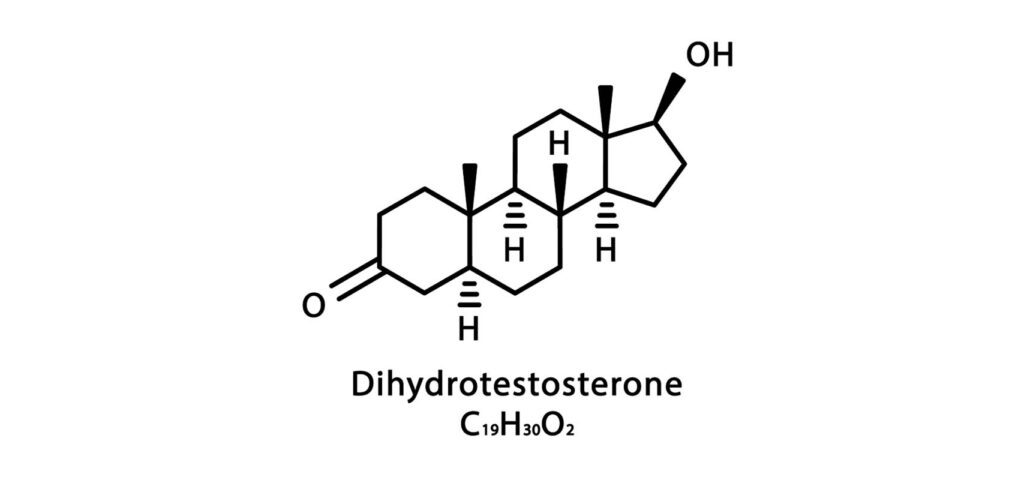DHT(dihydrotestosterone) is a natural steroid hormone that is produced and converted from testosterone by the enzyme 5-alpha-reductase. In the male body, DHT is one of the main androgens, the hormones responsible for the development and function of male sexual characteristics. It acts on the male body in several ways – first of all, it is essential for the development of the genitals and for maintaining their proper function. It also affects the development of hair – those on the scalp, but also throughout the body. In addition, DHT has a huge impact on prostate function, as well as libido levels.
- 1. What role does DHT play in the male body?
- 2. What exactly is DHT?
- 3. How does dihydrotestosterone work?
- 4. Why are DHT levels in the blood tested?
- 5. Why are dihydrotestosterone levels elevated?
- 6. What are the effects of elevated dihydrotestosterone?
- 7. What results in elevated dihydrotestosterone levels?
- 8. How to treat elevated DHT levels?
- 9. Dihydrotestosterone and androgenetic alopecia
What role does DHT play in the male body?
Dihydrotestosterone, unlike testosterone, has a much stronger effect on androgen receptors. It exerts up to three times more intense effects on tissues than testosterone. DHT is responsible for most of the embryonic development of the external genitalia. In fetuses, this hormone determines the formation of the penis and scrotum. Excessive DHT is the direct cause of male pattern baldness. Its levels are directly linked to the occurrence of prostate hypertrophy. High levels of DHT contribute to the development of prostate cancer. DHT is used in some countries as a treatment for men diagnosed with too low levels of sex hormones.
The hormone is also responsible for the appearance of facial hair and body hair. Its activity also affects the proper work of the prostate gland and seminal vesicles. Dihydrotestosterone is a tissue hormone that acts at the site of testosterone formation. In different areas of the body, its levels can vary widely.
What exactly is DHT?
It is the most biologically active form of the most important male sex hormone – testosterone. It is formed in the organs and tissues of the body as a result of testosterone maintenance. Determination of DHT levels in the blood is important information for fertility diagnosis. Trouble with DHT is also a cause of baldness.

Testosterone is the primary form of DHT, whose structure is based on 19 carbon atoms. SHT is formed from testosterone in organs of the body, such as the prostate and epididymis. Like testosterone, it can inhibit GnRH release in the hypothalamus through a negative feedback mechanism. As a result, it reduces the production of testosterone and DHT. The normal values of this hormone in the blood are 0.16-1.10 ng/ml for men and 0.06-0.2 ng/ml for ladies. It can bind to androgen receptors in the sex organs. In their inactive state, these receptors are bound to receptor-stabilizing proteins in the cell’s cytoplasm. The mode of action of dihydrotestosterone is virtually the same as that of testosterone, but the former hormone is much more potent.
How does dihydrotestosterone work?
In the body, the process of converting testosterone to DHT occurs all the time. This is possible and regulated by the enzyme 5-alpha reductase. Conversion takes place only in target cells that contain the enzyme. Dihydrotestosterone has a multifaceted effect:
- Is important for the embryo,
- Is responsible for the development process of boys during puberty,
- controls male body hair, beard growth or sebaceous gland function,
- affects the development of the prostate,
- Helps control the action of hormones,
- Is responsible for the development and function of the male genital organs.
Because DHT plays such an important role in the body, both elevated and reduced DHT can pose health risks.
Why are DHT levels in the blood tested?
Dihydrotestosterone is a very important hormone, the level of which should be regularly verified with a blood test. The process of testosterone formation is controlled by Lutropin, which is under constant control by the intercerebral hormone GnRH. It is released in boys and men from puberty through adulthood. In tissues and organs, testosterone is converted into DHT – the most biologically active hormone, so it strongly affects body functions. Its level is measured to detect problems that arise in the body. The most common abnormalities in the results involve elevated levels of dihydrotestosterone. This is the result of taking exogenous testosterone or other anabolic steroids, which are used by athletes and physically active people. Another cause of too much DHT may be an active testicular tumor lesion.
Why are dihydrotestosterone levels elevated?
Elevated DHT levels in the blood are responsible for, among other things. Steroid consumption or testicular tumor. This is a very dangerous condition for health, which can lead to irreversible disorders. However, there are many more reasons for this phenomenon. In women, elevated levels of the hormone are due to a disruption between the work of estrogens and androgens. This condition in the body is also due to hyperprolactinemia, adrenal tumors and adrenal hyperplasia.
What are the effects of elevated dihydrotestosterone?
Elevated levels of this hormone mainly result in hair loss and baldness problems in men. The most vulnerable follicles are located in the frontal area, where a reduction and gradual loss of follicles can be observed first. Men who have a hereditary hypersensitivity to dihydrotestosterone must remember that they are much more likely to develop premature androgenetic alopecia. However, this is not the only health problem that men with too much DHT can face. Unstable levels of the hormone can also cause high sexual desire or male genital dysfunction.
What results in elevated dihydrotestosterone levels?
This is usually due to congenital 5-alpha reductase deficiency, which in turn leads to DHT deficiency. The enzyme that is responsible for converting testosterone to DHT when disturbed results in testosterone levels in the upper normal range, while dihydrotestosterone levels are very low – up to three times the normal result for men.
The consequence of this situation is pseudohermaphroditism in children. This means that there are ambiguous genitalia that externally resemble female genitalia. An incompletely formed vagina and a small phallus that resembles a clitoris are usually observed. The nuclei are not subject to descent, so they are invisible.
Since boys with the condition do not have visible male genitalia, they are raised as girls. During puberty, however, they develop male secondary sexual characteristics. The phallus also enlarges and there is testicular descent, deepening of the voice and typical male-musculoskeletal development.
How to treat elevated DHT levels?
Testosterone levels in the blood fluctuate each day, with the highest values occurring in the morning. The production process of this hormone decreases with age, but DHT does not undergo daily fluctuations or lower production. The problem with elevated dihydrotestosterone is therefore not related to an excessive amount of testosterone in the blood. Treatment of its excessively high levels usually involves the administration of 5-alpha reductase inhibitors. However, if you notice a tendency towards hair loss and oily hair, you should act as soon as possible and consult a trichologist.
Another technique for treating elevated dihydrotestosterone, is the use of rubs and oils. Anti-DHT substances that reduce its levels in the hair follicles and inhibit the activity of the enzyme 5-alpha reductase also work well. Among the most popular are green tea or biotin.
Dihydrotestosterone and androgenetic alopecia
Androgenetic alopecia is a condition that affects men of all ages – even teenagers! Scientists over time have discovered that DHT is responsible for the occurrence of this condition. The higher the concentration of DHT, the more intense the process of hair follicle destruction.
Nowadays, there are two most popular pharmacological agents available on the market for the treatment of androgenetic alopecia – finasteride and minoxidil. The latter is responsible for stimulating hair growth, extending the growth phase of the follicles. Treatment with these drugs must always be under the supervision of a specialist. Such a doctor has experience in diagnosing scalp diseases.





